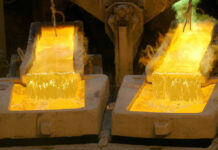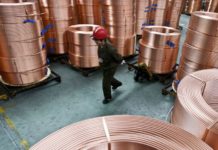
[miningmx.com] — BHP BILLITON and Rio Tinto have raised their bets on global copper demand, approving plans for a $4.5bn expansion of the massive Escondida mine in Chile, while BHP plans to reopen a US copper mine idled three years ago.
The two miners are already spending billions of dollars expanding output at their Australian iron ore mines to feed Chinese demand, and the push to boost output by 80% at the world’s biggest copper mine underscores their optimism about longer term demand for metals.
The price of copper, seen as a bellwether for industrial demand, has fallen 17% from record highs above $10,000 a tonne a year ago, but is still more than double the level reached in the depths of the global financial crisis.
“The market wants more copper,” said UBS analyst Glyn Lawcock, pointing to tight global supplies of the metal used for everything from power transmission to plumbing.
The $4.5bn investment at Escondida, where production last year fell 25% due to declining ore grades, has been well flagged, but BHP’s decision to start mining again in late 2012 at Pinto Valley in Arizona came as a surprise.
“They must be happy with the outlook for copper and the cost structure of that asset,” said Ric Ronge, a portfolio manager at Pengana Capital, which owns BHP shares.
Analysts said cheaper energy prices in the United States had probably helped to justify the planned $195 million investment to restart the mine, at a capacity of 60,000 tonnes a year, in what the major miners see as a tight market in the medium term.
“It’s probably fair to assess that you’re going to see similar sorts of things from a number of companies who have operations that have been sitting idle waiting for the right environment,” said UBS’s Lawcock.
LONG LIFE
The projects approved on Tuesday will not have any impact on the market for the next 12 months, when sluggish demand from top copper consumer China is expected to weigh on prices.
But in the medium to long term, the market will need the copper for buildings and infrastructure in the rapidly industrialising and urbanising Asian countries, even if growth rates slow somewhat.
“This should firm up the longer term supply picture which had been looking like it might revert into deficit by the end of the decade because of the limited number of concrete projects that have got past feasibility stage,” said Nick Trevethan, senior commodities strategist at Australia and New Zealand Banking Group.
The global market for refined copper is expected to be in surplus of 718,000 tonnes in 2015, switching to a deficit of around 316,000 tonnes by the end of the decade, according to Reuters calcuations based on Wood Mackenzie figures.
Over that time, the market for refined copper is seen growing from around 24 million tonnes to 27 million tonnes.
The $4.5bn investment at Escondida, where production last year fell 25% due to declining ore grades, has been well flagged, and the cost was in line with analysts’ expectations.
The Escondida expansion is one of BHP’s top priority projects, part of an $80bn capital spending plan through 2015, including its Olympic Dam copper and uranium mine and iron ore expansions in Australia, shale gas development in the United States and potash development in Canada.
BHP, operator of the mine, also upped the ore reserve estimate by 25% and said the giant mine should be able to sustain production for more than a century.
BHP plans to spend $2.6bn on two projects to boost output at the mine, while Rio’s share of the projects is $1.4bn and Japanese consortium JECO, which holds a 12.5% stake, will cover the rest.
The projects are designed to give the partners access to higher ore grades, with a new 152,000 tonnes a day concentrator plant and new mineral handling system that will boost production to more than 1.3 million tonnes a year by June 2015, or about 5 percent of the global copper market.
The mine produced about 760,000 tonnes of copper last year.











